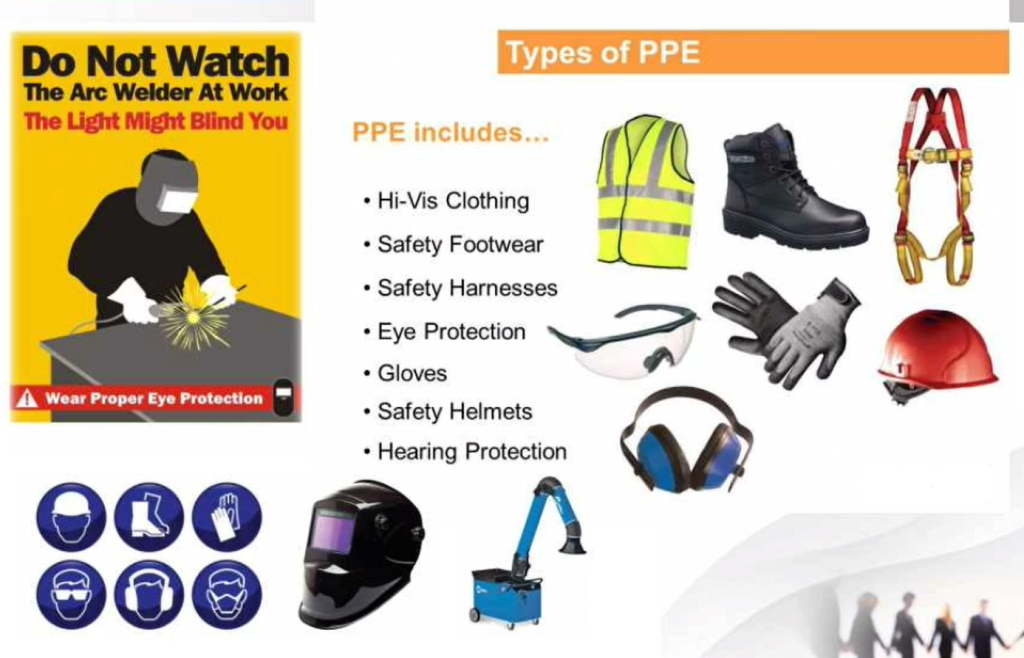Welding can be a hazardous process, and it’s essential to follow safety precautions to minimize the risks. Here are some general welding safety tips to keep in mind:

- Wear protective clothing: Wear protective clothing, including welding gloves, goggles, and a helmet with a filter lens to protect your eyes and face from the bright light and sparks generated by the welding process.
- Ventilation: Ensure that there is adequate ventilation in the area where you are welding. Welding produces gases and fumes that can be harmful when inhaled.
- Keep the workspace clean and tidy: Make sure that the welding area is free of flammable materials, such as paper, chemicals, or solvents, and that the floor is clean and dry.
- Check equipment regularly: Before starting any welding job, inspect the welding equipment for any defects or damage. Make sure that all cables and hoses are in good condition and that the welding machine is grounded properly.
- Follow proper welding procedures: Follow the manufacturer’s instructions and safety guidelines for the equipment you’re using. Always use the proper welding technique for the job and use the right welding rod for the material you’re working on.
- Keep a fire extinguisher nearby: Have a fire extinguisher nearby in case of any fires caused by sparks or overheating.
- Train workers: Ensure that all workers involved in welding have received proper training in safety procedures, and that they are aware of the potential hazards of the job.
By following these safety tips, you can reduce the risk of injury or accidents while welding.
Welding Safety Equipment
There is a range of safety equipment that should be used when welding. Some of the essential safety equipment includes:
- Welding helmet: A welding helmet is a protective gear that shields the face and eyes from harmful ultraviolet (UV) and infrared (IR) light emitted during welding.
- Welding gloves: Welding gloves provide protection for the hands and wrists from sparks, heat, and molten metal splatters.
- Welding apron: A welding apron is designed to protect the body from sparks and heat generated during welding.
- Welding jacket: A welding jacket is made from flame-resistant materials and is designed to protect the upper body and arms from heat and sparks.
- Respirator: A respirator protects the welder’s lungs from hazardous fumes and dust that are released during welding.
- Safety glasses or goggles: Safety glasses or goggles protect the eyes from flying debris, sparks, and harmful radiation generated during welding.
- Welding boots: Welding boots provide protection for the feet and toes from falling objects and molten metal splatters.
- Earplugs: Earplugs are essential to protect the welder’s ears from loud noise generated during welding.
It’s essential to wear the appropriate safety equipment when welding to reduce the risk of injury and ensure safe working conditions.
Welding Safety Glasses
Welding safety glasses, also known as welding safety goggles, are a type of protective eyewear that is designed to protect the eyes from the bright light and sparks generated during welding. Welding safety glasses are typically made with lenses that are darkened to filter out harmful ultraviolet (UV) and infrared (IR) radiation that is generated during welding. They can also protect against flying debris and other hazards that may be present in the welding environment.
When selecting welding safety glasses, it’s important to consider the type of welding you’ll be doing and the specific hazards that may be present. Some welding safety glasses are designed to be worn over prescription glasses, while others may be used on their own. In addition, welding safety glasses are available in different lens shades, ranging from lighter shades for lower amperage welding to darker shades for higher amperage welding.
When using welding safety glasses, it’s important to ensure that they fit properly and are comfortable to wear for extended periods. Welding safety glasses should also be inspected regularly for damage or signs of wear and replaced as needed to ensure continued protection.
10 Welding Safety Rules
Here are ten welding safety rules that should be followed to ensure a safe working environment:
- Wear the proper personal protective equipment (PPE), including welding gloves, helmet, safety glasses, and clothing.
- Ensure that the welding area is well-ventilated to prevent the accumulation of hazardous fumes.
- Inspect welding equipment before each use to ensure that it is in good working condition and that all cables and hoses are properly connected.
- Never weld on materials that have been exposed to flammable or explosive substances, such as gasoline, oil, or solvents.
- Avoid welding in wet or damp conditions, which can increase the risk of electric shock.
- Keep the work area clean and free of debris, and ensure that all equipment is properly grounded.
- Follow proper welding techniques and procedures, and use the appropriate welding rod for the material being welded.
- Use caution when handling hot materials, and always wear heat-resistant gloves.
- Keep a fire extinguisher nearby in case of a fire caused by sparks or overheating.
- Provide proper training for all employees involved in welding to ensure that they understand the hazards and know how to use the equipment safely.
By following these ten welding safety rules, you can help prevent accidents and create a safe working environment for everyone involved.
